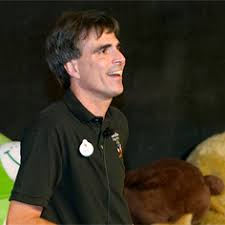Randy Pausch

What can we learn about teaching and learning?
This is the driving question of our career as future educators. In
Randy Pausch's last lecture, he gives some answers to that very question. Randy begins by talking about achieving your dreams. Randy says that "when your screw up and no one is saying anything to you anymore, that means they gave up on you." He says to let others critique you because this only makes you better. It is your critics that help propel you to reach your highest potential. It is in the project
failures that we gain our experiences. This isn't the time to quit but to use the failure to help you reach your overall goal. "Brick walls are there to show how badly we want something, they only stop people who don’t want it badly."
Throughout Randy's lecture, he is very animated, he relates real life stories along with props and visual aids and it is a collection of all of these tools that make Randy's lecture come alive and create a power to connect to the audience. It is important as teachers that we engage the students and give them ways to connect with the lesson. It has to be more than words on a page and Randy masters that.
Randy goes on to tell about when he was a student at Carnegie Mellon and states that their instructors “gave them the reigns” and there were “no deans to report to", they had "license to break the mold, project-based curriculum, intense fun student experience, field trips” They called it “edutainment” because it was as much entertainment as it was education.They did things differently! (This is project based learning.)
Through many of his experiences, lessons were learned about how to achieve his dreams. Randy says that important people who helped him achieve his dreams were his parents, his teachers, mentors, friends and colleagues. We also have people in our life that will help us achieve our dreams and we in turn should help others achieve theirs.
Randy also adds that we can learn from our students and that it is important that we take our life experiences plus lessons taught in school and use the examples from the important people in our lives to create learning experiences. We are students of our environment as well as in the classroom. Learning is a life long experience,not something that ends once we get a degree. Randy's final lecture is rich with good advice taught by someone that has learned as much from failure as from success!
So, what can we learn about teaching and learning? First,both teaching and learning are cyclical, and perpetual. Second, learning is not only about the student learning from the teacher but the teacher learns from the students as well. Third, take time to listen and learn from the important people in your life and in turn help others, Fourth, always be a student of your environment (life is full of many lessons)and finally, be thankful and show gratitude.










